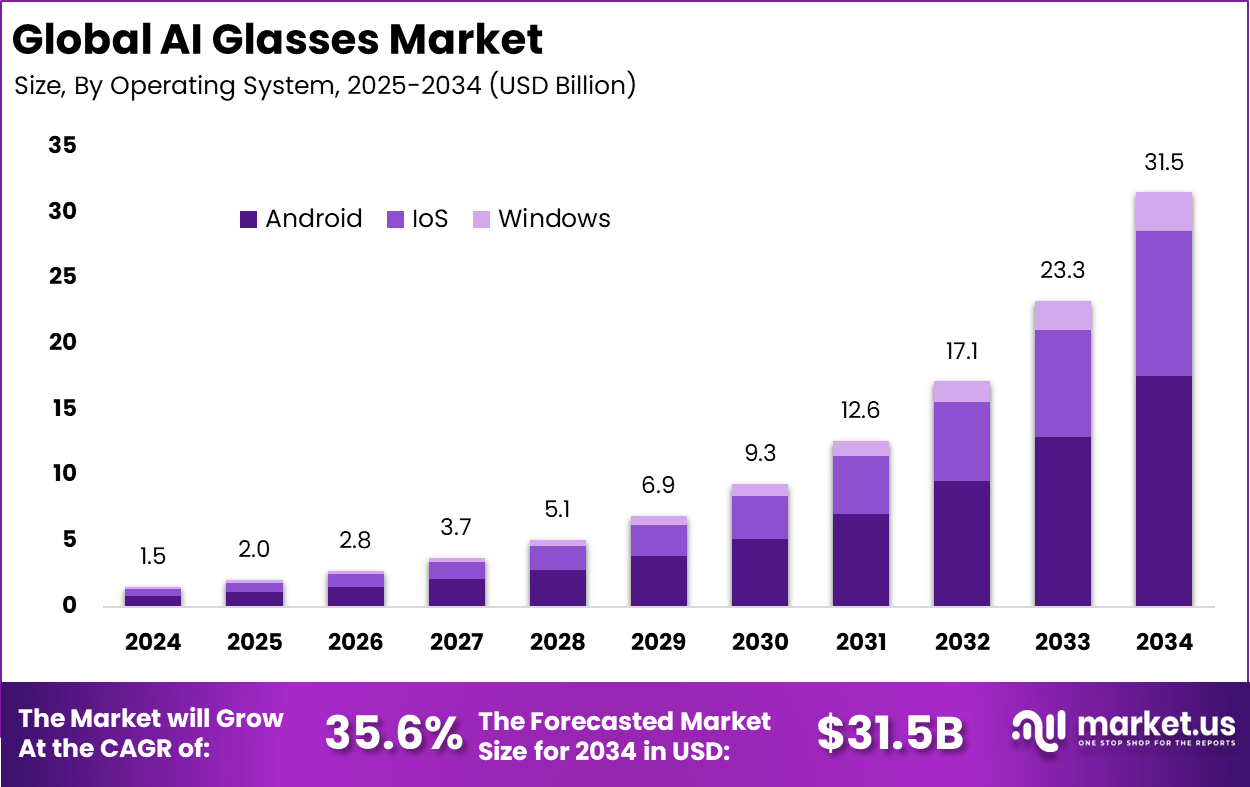Table of Contents
Introduction
The global AI Glasses Market, valued at USD 1.5 billion in 2024, is projected to reach USD 31.5 billion by 2034, registering an impressive CAGR of 35.6%. Growth is driven by advances in augmented reality, wearable computing, gesture recognition, edge-AI processing, and hands-free productivity tools. North America dominated the market in 2024, capturing 36.2% and generating USD 0.54 billion in revenue. Increasing demand for immersive experiences, workplace efficiency, and AI-powered personal assistance is accelerating global adoption.

How Growth Is Impacting the Economy
AI glasses are positively influencing economic development by stimulating investment in wearable hardware, optics, semiconductor components, and AR software ecosystems. Their adoption in industrial automation, logistics, retail, and healthcare is driving operational efficiency, reducing errors, and improving workforce productivity.
This technological shift is boosting high-value manufacturing, strengthening digital infrastructure, and opening new employment opportunities across AI engineering, optical design, UX development, and cloud integration. As enterprises automate workflows and adopt real-time visual guidance systems, national economies benefit from reduced downtime and improved output quality. The emerging creator and developer ecosystem surrounding AR applications further contributes to economic expansion, supporting startups and accelerating innovation across multiple sectors.
➤ Smarter strategy starts here! Get the sample – https://market.us/report/ai-glasses-market/free-sample/
Impact on Global Businesses
Rising adoption of AI glasses introduces higher procurement and integration costs due to advanced sensors, micro-LED displays, and AI processors. Supply chains are shifting toward diversified semiconductor suppliers and optical component manufacturers. Sector-specific impacts include improved assembly-line guidance for manufacturing, enhanced order picking for logistics, real-time patient data access for healthcare, immersive customer engagement for retail, and training efficiency for defense and enterprise environments. These shifts elevate digital maturity but require strong IT support and workforce adaptation.
Strategies for Businesses
Businesses should adopt scalable AR platforms, invest in staff training, develop customized AI-assisted workflows, and ensure secure cloud integrations. Prioritizing interoperability, lightweight hardware adoption, and multi-vendor supply chains reduces risks. Companies should focus on pilot testing, analytics-driven optimization, and industry-specific AR applications for maximum ROI.
Key Takeaways
- CAGR of 35.6% driven by AR adoption and AI-assisted workflows
- North America leads global adoption with strong enterprise demand
- AI glasses improve productivity, reduce errors, and enhance worker safety
- Supply chains shifting toward optics, sensors, and semiconductor diversification
- Strong growth opportunities in industrial automation, healthcare, and logistics
➤ Unlock growth secrets! Buy the full report – https://market.us/purchase-report/?report_id=165351
Analyst Viewpoint
The AI glasses market is gaining strong momentum as enterprises shift toward immersive, hands-free operational environments. Current deployments focus on industrial tasks, remote collaboration, and real-time data visualization. Future outlook remains highly positive with expected advances in micro-display technology, edge-AI efficiency, and ergonomic designs. Adoption will accelerate across consumer and enterprise markets as devices become more affordable, feature-rich, and integrated with AI assistants.
Use Case and Growth Factors (Table)
| Use Case | Growth Factors |
|---|---|
| Industrial remote assistance | Demand for real-time guidance, reduced downtime |
| Warehouse picking | Need for accuracy and speed in logistics |
| Healthcare diagnostics | Access to hands-free patient data and imaging |
| Retail customer engagement | Growth of AR-powered shopping experiences |
| Field service & repair | Rising need for expert-guided workflows |
Regional Analysis
North America leads with strong enterprise digitalization, early AR adoption, and investments in immersive technologies. Europe follows with industrial automation initiatives and growing healthcare use cases. Asia Pacific is the fastest-growing region due to expanding manufacturing bases, rising consumer tech adoption, and heavy investment in AR ecosystems. Latin America and the Middle East are gradually modernizing logistics and enterprise operations, creating future opportunities for AI glasses deployment.
➤ Want more market wisdom? Browse reports –
- Smart Contracts In Trade Finance Market
- Brokers & Corporate Agents Market
- Earned Wage Access Providers Market
- Ems & Odm Market
Business Opportunities
Major opportunities lie in AR-based workforce training, remote maintenance, immersive retail experiences, AI-driven personal assistants, and consumer-grade smart glasses. Enterprise demand for hands-free documentation, safety monitoring, and error reduction creates long-term value. Startups focusing on optical innovation, AI-powered gesture control, and vertical-specific AR applications can capture emerging niche markets.
Key Segmentation
The market spans product types such as monocular smart glasses, binocular AR glasses, mixed-reality glasses, and fully immersive AI-enhanced wearables. Core applications include industrial automation, logistics, healthcare, retail, consumer entertainment, field service, and defense training. Technologies include micro-LED displays, waveguide optics, edge-AI processors, computer vision, and voice-based AI support, deployed via cloud or on-device architectures.
Key Player Analysis
Market participants focus on enhancing display resolution, reducing device weight, improving battery efficiency, and strengthening AI-assisted workflows. Strategies include expanding AR software ecosystems, forming enterprise partnerships, and integrating advanced computer vision. Companies are investing in ergonomic designs, modular components, and security-enhanced cloud platforms to broaden adoption. Emphasis on affordability, durability, and scalable deployment models is shaping competitive positioning.
- Vuzix Corporation
- Meta Platforms, Inc.
- EssilorLuxottica
- TCL Electronics Holdings Limited
- Lenovo Group Limited
- Innovative Eyewear Inc.
- Amazon.com, Inc.
- Huawei Investment & Holding Co., Ltd.
- Xiaomi
- Snap Inc.
- Razer Inc.
- Dynabook Americas, Inc.
- RealWear, Inc.
- Other Major Players
Recent Developments
- April 2024: Launch of ultra-light industrial AR glasses with upgraded edge-AI support.
- June 2024: Integration of real-time 3D mapping into enterprise AI glasses platforms.
- September 2024: Introduction of consumer-grade AI glasses with enhanced gesture recognition.
- January 2025: Release of medical visualization glasses for hands-free diagnostics.
- March 2025: Expansion of cloud-connected AR applications for logistics and manufacturing.
Conclusion
The AI Glasses Market is rapidly transforming workflows through immersive, AI-powered capabilities. With strong growth, expanding applications, and advancing hardware, the sector is set to shape the future of enterprise and consumer innovation worldwide.
Discuss your needs with our analyst
Please share your requirements with more details so our analyst can check if they can solve your problem(s)



